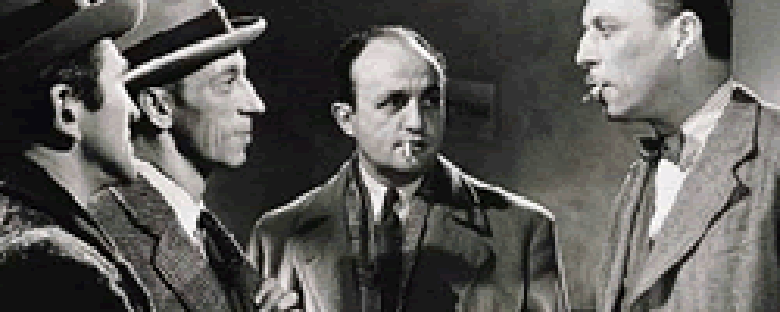Reviews
Henri-Georges Clouzot
France, 1947
Credits
Review by Rumsey Taylor
Posted on 11 July 2004
Source The Criterion Collection DVD
Quai des Orfèvres finds Henri-Georges Clouzot in trademark form — camera movement and ambiance are each expectedly embellished and ripe — although it displays the accomplished director well-confined within a genre. This, his first postwar film (following the misanthropic Le Corbeau, which triggered his suspension from the French film industry), is a work that promises exercise. Fortunately, Clouzot’s later Diabolique and Wages of Fear would allow similar opportunity and increased freedom.
Jenny is a nightclub singer and nude model (her photographer is female, and the relationship between them is suggestively homoerotic — see: Diabolique). Her husband, Maurice, is cold and primarily disaffected until his jealousy — his most intense emotion — fuels his marital defense. Jenny encounters a “lecherous movie financier” during a routine shoot. His reputation elicits great warning in her photographer and increased jealousy in Maurice. The setup is that these are slightly naïve characters (prior to the incriminating conflict, each is crimeless). Crime will infest them. And it will be deliciously complicated.
In traditional noir fashion, Quai des Orfèvres opposes parties involved in the central crime against legal investigators. However, there is little moralistic establishment. The crime is largely the product of accident (which should be stressed) and affiliation, and the pursuers, keenly attuned to procedural mechanics, are looking for a motive, weapon, and suspect — each of which is creatively supplanted in the film. Assigning guilt, in this scenario, will be a falsely representative tactic.
Familiarity with noir mechanics yields the creative strength of Quai des Orfèvres. In one scene, a mockery of the genre’s liberal use of shadows, Maurice enters his apartment and activates each light in patient succession. The lighting rhythm culminates and arrives in the sight of a gun — it is a weapon unused in the central crime, yet, as Clouzot would likely attest, is a prop essential to the genre. The film, secondly, contains several characters who smoke, several of whom deliver dialogue with cigarettes fumbling in their moving lips, and pockets of smoke emanating from their speaking mouths. It is a noticeably awkward detail, and perhaps deliberately exaggerated; it is a director’s clever wink.
Clouzot’s commanding direction (comparisons to Hitchcock are inevitably frequent and earned) and understanding of the genre is excitingly apparent. Notice how Antoine, the head investigator, interrogates Jenny and Maurice at their apartment, and uses a crucially incriminating clue to light his pipe. The married couple looks at each other, convinced — for the first time — of each other’s involvement. We watch the scene with a similar revelation.
Quai Des Orfèvres is a patent genre film. Its construction and basic atmosphere are routinely familiar, although its particular actions are creative and welcome. It is distinguished, and my recommendation is inhibited only by knowledge of Clouzot’s later efforts.
We don’t do comments anymore, but you may contact us here or find us on Twitter or Facebook.



